Introduction
The Nikon Coolpix L320 is an easy to use long zoom compact camera. Shaped like a compact DSLR, the camera sports a large 26x optical zoom, 16 megapixel CCD sensor, 3 inch LCD screen, EXPEED C2 processor and takes AA batteries. Coupled with the wireless transfer via Eye-Fi memory cards and the L320 pans out to be a camera for the traveller or keen walker. Priced at around £190, the L320 is available in black.
Ease of Use
For those of you interested in the shape, feel and flexibility of a DSLR or large zoom prosumer camera, you'll be pleased to know that if you don't have the funds available for an expensive model, the Nikon Coolpix L320 is a budget version of other models in the “L” range. It's a smaller brother of the L820 but is pretty much a clone when it comes to the exterior. The L320 has a smaller zoom, reaching to a maximum 26x optical. That still offers you an ultra-wide 22.5mm before zooming out to a nail biting 585mm. Great for if you're walking out in the countryside and there's an interesting natural event that needs a picture, but it's too far away. The zoom is operated via the zoom switch found wrapped around the shutter release on the corner of the grip. Behind this on the main top plate is a small power button. It's sunken into the body so as not to get caught by accident in the heat of the moment.
The idea behind the design of the large grip is to make it easier to hold and to shoot one handed. The weight of the lens is nicely counter-balances the batteries so that the camera is balanced. All the main controls have been placed on the back of the camera and are easily accessible by the thumb that will naturally rest there. The video record button sits on the shoulder and this can be used regardless of whether you're taking pictures or not. In fact, the video mode has been removed from the camera because the video button made it redundant.
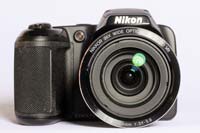 | 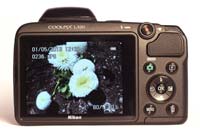 |
| Front | Rear |
Should you want to choose a mode to take pictures in, this is done by pressing the green camera button on the back of the Nikon Coolpix L320. A simple menu will come onto the screen and it allows you to choose from four shooting modes: Easy auto, Scenes, Smart portrait and Auto. The Easy auto mode is – essentially – an automated version of Auto mode. It takes all the decision making out of your hands while still ensuring the correct scene is selected. It does this by analysing the scene as you start to use the camera. It then selects the appropriate mode for the scene it's viewing. For example, it it locates a face, it'll assume you're taking a portrait. It will automatically switch into portrait mode, enable face detection and the flash (if it's in the up position).
The Scenes will allow you to take control of the situation you're in and choose the Scene you want to shoot in. There are 18 to choose from ranging from the typical landscape, portrait and sport modes to more niche options such as museum, panorama and backlit subject. Smart portrait mode utilises every mode and feature of the camera to ensure you get the best portraits such as face detection, blink detection, skin softening and red-eye fix. The final option is the general everyday mode to shoot in. It's useful if you don't want the camera to mess about or require something more routine.
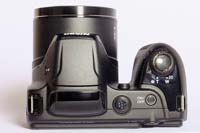 | 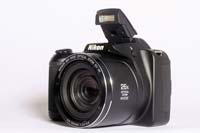 |
| Top | Side |
The battery compartment is located on the bottom of the Nikon Coolpix L320 and blessedly has a locking switch. AA batteries tend to impose a degree of pressure on the battery door and it could spring open at an embarrassing moment if it didn't have the lock. We would have liked to see a metal tripod bush on a camera with such a long zoom lens so that you can select a low ISO in the Main menu and keep the noise down while using the zoom or shooting at night.
The Main menu can be accessed by pressing the Menu button on the back of the camera. There are three tabs on the left which you can access by pressing left on the navigation pad. This will flick through the camera, video and main Set-up menus. The Shoot menu, denoted by a green camera, has only five options to it and they all alter the immediate way the camera takes pictures. For example, you can change the resolution, white-balance or ISO. There's also an option for continuous shooting and various colour options such as Vivid, black & white, sepia and cyay Taboola
Start up from cold is around 2.8sec which is slower than average of 2.5sec. However, we have to take our reflexes into consideration. The reason being that the shutter button can't be simply pressed down with the aim of taking a picture once switched on. The camera won't register the button being pressed if it's done before it's finished the start up cycle. Given that we have a reflex response time of around 0.4sec, that would take the camera to around the average speed for a start up time. We managed to get seven pictures in a 10 second time-frame which works out around 0.7fps (frames per second). The first four frames record in around 2.5 seconds, which is 0.6fps, not the 1.2fps that Nikon state on the website. We even tried dropping down to the standard resolution, but got similar results.
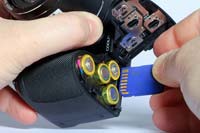 | 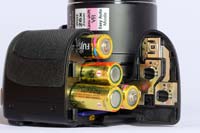 |
| Memory Card Slot | Battery Compartment |
Press the Playback button and the most recent picture you took will come up on screen, full screen, for you to review. Basic details of the picture are flashed up on screen for a few seconds before they disappear to just the image. You can zoom in using the zoom switch and check sharpness of focus and you can also move around the picture using the navigation pad. Zooming out lays the pictures out as thumbnails for you to review multiple ones at once. In the Playback menu, you can alter the appearance of pictures using the many editing options available such as D-Lighting control, skin softening, rotation, protect and copy. There's also provision to create a slide-show.
In the box, you'll find some practical accessories for your camera such as a pack of batteries to get you started. The great news about batteries that are provided these days is that they're generally very good. Certainly the Nikon ones are. The pack we had lasted us the entire test and beyond. There's also a neck strap, lens cap and USB lead. You also get some software in the shape of Nikon View NX2. The full manual is also located on the disc, although it doesn't say so. However, given that there's only a Quick Start Guide in booklet form, it's common sense




